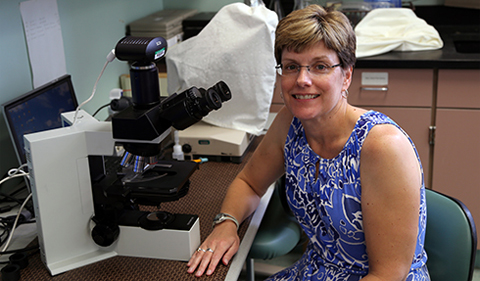The Environmental & Plant Biology Colloquium Series presents Dr. Morgan Vis on “Biogeography of Freshwater Red Algae: Changing Ideas about Cosmopolitan and Endemic Floras” on Friday, Oct. 16, at 11:50 a.m. in Porter 104.
Vis is Professor and Chair of Environmental & Plant Biology at Ohio University.
Abstract: Our understanding of the biogeographic patterns of freshwater red algae has changed considerably over the past 20 years. Systematic studies, first using morphometric analysis and later using molecular tools, have informed biogeographic ranges of many taxa. Some species once thought to be cosmopolitan have been shown to be more restricted in their ranges. Similarly, taxa previously considered to be restricted in range or endemic have been found to be more widely distributed than previously thought. There appear to be three general distribution patterns for species of freshwater red algae – taxa that are widespread within and among more than one continent, taxa that are restricted to a single continent, and taxa that appear common on one continent but restricted on another or restricted on both continents. All of these patterns are illustrated in the most species rich order, the Batrachospermales. Cosmopolitan species include Sirodotia suecica, which is the most widespread species with molecular data confirming genetically similar populations in North America, Europe, Australasia, and Africa. Other taxa have been noted as common on two continents such as Batrachospermum atrum from Europe and Australasia, B. gelatinosum from North America and Europe, and Kumanoa ambigua from North and South America. Many taxa appear to be more restricted in their range and have been only recorded from a single continent to date such as Kumanoa capensis in South America, Tuomeya americana in eastern North America, and Sheathia heterocortica in southeastern US. The disjunct distribution is seen in Sheathia involuta, which is common in North America, but even with broad sampling, has only been located in one part of Poland, Europe. Likewise, genetically identical Kumanoa mahlacensis has been collected from two locations, Texas, USA and Spain, but has not been collected at any other locations in North America or Europe. These new findings have both altered and confirmed our understanding of continental floras. We still have much to learn about the biogeography of the flora from each continent. In the future, we should concentrate on understanding the drivers of cosmopolitism and endemism in freshwater red algae. Based on the current phylogeny, cosmopolitan species are sister to more endemic taxa; why has one thrived over a broad geographic range and the other is more restricted? As well, most currently recognized genera are a mix of cosmopolitan and endemic taxa as well as having members on more than one continent; are there physiological differences among the species to explain their distribution patterns? Our picture of the global biogeography of the Batrachospermales remains unclear, but is coming into focus with broader geographic and taxonomic sampling using molecular tools.




















Comments